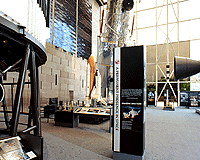
|
A PERMANENT
PRESENCE IN SPACE
"America
is too great for small dreams.... We can follow our dreams to distant
stars, living and working in space for peaceful, economic and scientific
gain. Tonight, I am directing NASA to develop a permanently manned space
station and to do it within a decade."
President
Ronald Reagan, 1984
"I
have decided today that the United States should proceed at once with
the development of an entirely new type of space transportation system
designed to help transform the space frontier of the 1970's into familiar
territory, easily accessible for human endeavor in the 1980's and 1990's."
President
Richard Nixon, 1972 |
|
Before
the race to the Moon ended, both the Americans and the Soviets were
planning their separate futures in space. After the competitive
short-term goals of manned spaceflight had been met in the 1960s,
many advocates of space exploration envisioned a permanent human
presence in space.
But
support for manned missions to the Moon and beyond declined, and
the focus for human activity in space shifted to near-Earth orbit.
During the 1970s and 1980s, the United States and the Soviet Union
took different approaches to manned spaceflight around Earth.
|

SI#: 97-17206 |
CHANGING
DIRECTIONS
After
the Apollo missions to the Moon, the United States began developing
an entirely new vehicle, the Space Shuttle. A reusable Shuttle would
make access to space "routine" for short but frequent
missions.
Meanwhile,
the United States used the last of its Apollo-era vehicles to launch
an experimental space station, Skylab, in 1973, and to participate
in a Soviet-American rendezvous in space, the Apollo-Soyuz mission,
in 1975.
The
Space Shuttle first flew in 1981. Proponents of a space station
as the next U.S. venture in space won presidential support in the
mid-1980s but faced continuing pressure to justify the program's
cost and purpose. A quarter-century after Skylab, after many delays,
the United States began to build a permanent base in space.
|
ON COURSE
The
Soviets gradually pursued a goal of establishing a permanent presence
in space. They adapted their Moon-era hardware to launch a number
of orbital space stations called Salyut, using Soyuz spacecraft
to ferry crews and supplies for missions of increasing duration.
In
1986 Salyut was succeeded by a modular space station, Mir, which
was used for more than a decade as new laboratory and power modules
were added. Some crew members spent a year or more on Mir. Cosmonauts
have been living and working in space almost continuously since
1971.
With
the end of the Cold War in the late 1980s and early 1990s, the two
manned spaceflight programs began to converge. Americans and Russians
worked together in joint missions on the Space Shuttle and Mir,
and in planning a new international space station. Competition has
yielded to cooperation in space.
|
|